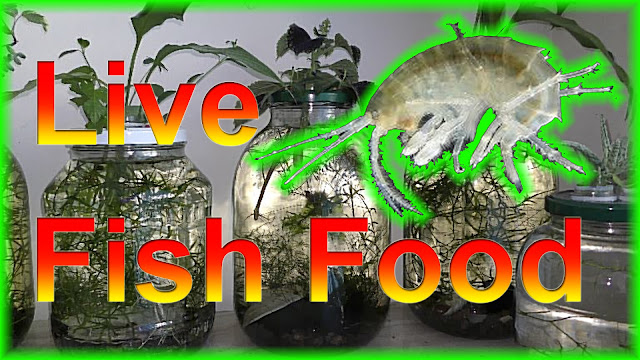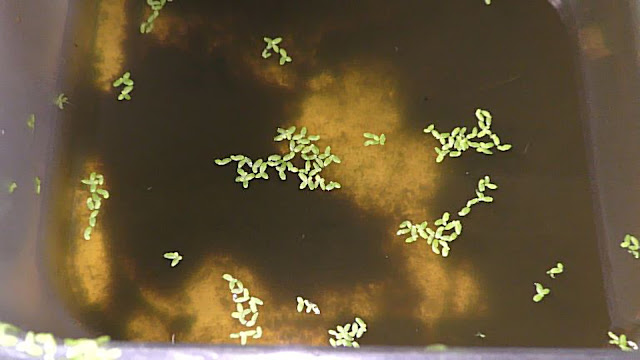Back in July 2019, I repurposed this old aquarium nursery to culture scuds.
Buy Scuds locally on Craigslist:
or buy Scuds on Amazon (paid link):
The colony of scuds (Gammarus) has grown really well in this tank for the past 4 months.
On November 10th, 2019 I decide to disassemble this nursery.
First, let's move duckweed.
Duckweed grows very well in this wide water surface tank serving as food for scuds.
That is how much duckweed I collect about once every month.
I use duckweed with snails and scuds caught with it to make fish food flakes.
Here we can see scuds dashing through the algae green water.
I feed scuds with algae and plants.
It turns out that scuds feed on everything, any organic detritus.
Scuds eat algae, but they do not keep aquariums clean from algae.
Adult scuds prefer more sizable food than algae.
Now, let's move scuds into a 3 liter glass jar.
I use a turkey baster (pipette) to move scuds into their new home.
Here you can already see enough scuds to start a couple new colonies.
Let's add cuttings of Elodea, or rather what is left of them, into the new nursery.
That is real evidences of what a crowd of scuds does to very fast growing plants.
Here are the remains of a fast growing Hornwort plant.
A big population of scuds makes quick work of all live plants in an aquarium, leaving algae for later.
That is something we have to be mindful about.
Also, it is very easy to control algae in aquariums as you may know from my latest video about it.
I think scuds appetite for plants can be helpful in sustainable aquariums with fish.
Okay. Snails, rocks, shells, driftwood - all goes into the new nursery.
The dirt from the old nursery goes into the trash.
I feed a dry mulberry leaf to scuds once a week or so.
They jump on it right away.
Cover the nursery with a planter to reduce water evaporation.
January 25th, 2020 I set up a new 3 liter jar nursery for another colony of scuds.
First, fill the jar with chlorinated water and let it sit overnight for chlorine to evaporate.
The next day I add sea shells.
Now I move some plants and mulberry leaves from the old nursery to the new one.
It comes with many scuds - you can see them dashing down from plants.
So, now I have two 3 liter nurseries to breed scuds.
I always cover my aquariums with planters to reduce water evaporation.
Planarians also get into the new nursery.
Here I see some more.
I like planarians.
Also, I add fast growing Guppy grass and Duckweed.
Feeding scuds with mulberry leaves is optional - they should be fine with aquatic plants.
10 days later, on February 6th, I feed scuds again with Mulberry leaves.
Notice: the previous food is all gone.
April 24th, 2020.
Algae has been building up for about 4 months in the old nursery on the left and it's been blooming in the first nursery.
Scuds seem to breed fine in green algae water.
Just for example, let me pull some scuds from this algae green nursery.
You can see how many different sized scuds live in this green water.
With many aquatic plants available for scuds to chew on, reducing feeding scuds to once a month makes no difference to their breeding rate.
I set up more than one colony of scuds in order to have plenty of scuds for feeding fish in aquariums at any time.
Initially, I feed scuds to my dwarf guppies simply by transferring a dozen or so scuds from the nursery into an aquarium with fish.
Notice how the male guppy goes after a scud.
Feeding fish with regular homemade fish food flakes distracts fish from hunting scuds.
So, I start adding scuds right as fish eat flakes at regular feeding time.
More scuds survive this way.
You can see a scud on the right is dashing to the bottom where it can hide from fish.
But even more importantly is that I don't use man-made filters and air pumps, and I do not change water in my sustainable aquariums with fish.
Which means that any surviving scuds will live and breed right in the aquarium where fish can find and eat them.
Changing water in this aquarium will reduce the population of scuds more than fish can ever hope to.
In sustainable aquariums, fish feed on what grows in the aquariums.
The food I give them is also made of what grows in aquariums.
And fish learn quickly where to find the most desirable food - they are picking on scuds right here.
Adult scuds are too big for my dwarf guppies.
Toothless guppies can not handle scuds half the size of adult fish.
Guppies are hunting scuds that they can swallow - young scuds.
Once I introduced scuds in all aquariums with fish, I stopped adding any more scuds.
Adult scuds find plenty of food and space in aquariums allowing them to breed all year around.
Here is an example of a sustainable aquarium with more than a year old colony of scuds.
There are many adult scuds digging through detritus in the gravel.
Fish roam around picking small young scuds that may get caught off guard.
The large adult scuds are too big for my guppies.
Small fish cannot swallow them.
And so the adult scuds are left to breed, providing continuous supply of young scuds.
Some young scuds survive long enough to grow too big for my fish.
And that is how this colony of scuds keeps growing.
Time lapse recording reveals fish roaming continuously through regions populated with scuds.
Not surprisingly, I hardly can see any young scuds - they should be hiding very well.
So, instead of keeping dedicated aquariums for breeding scuds I now have colonies of scuds breeding right in my aquariums with fish that eat them.
It saves me time, effort, and space.
And fish get live food all the time.
Transferring scuds into a new aquariums is as easy as moving any plants from the old aquariums.
Scuds cling on plants and roots of the plants.
Here is one and who knows how many more are hiding there.
Here is a close up view of a breeding couple of scuds.
I see another one on the back.
It is actually hard to spot scuds in an aquarium with many plants.
Plants serve as hiding places for scuds and as their source of food.
So again, I breed scuds in sustainable aquariums with fish.
Without water changes, no man-made filters, no air pumps.
It works well for the past year so far.
Have fun and happy aquarium gardens :)

















































































No comments:
Post a Comment